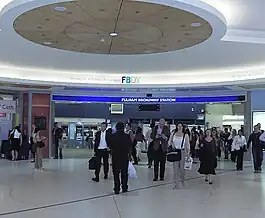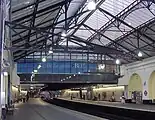| Fulham Broadway | |
|---|---|
 | |
 Fulham Broadway Location of Fulham Broadway in Greater London | |
| Location | Walham Green |
| Local authority | Hammersmith and Fulham |
| Managed by | London Underground |
| Number of platforms | 2 |
| Accessible | Yes[1] |
| Fare zone | 2 |
| London Underground annual entry and exit | |
| 2018 | |
| 2019 | |
| 2020 | |
| 2021 | |
| 2022 | |
| Railway companies | |
| Original company | District Railway |
| Key dates | |
| 1 March 1880 | Opened as Walham Green |
| 1 March 1952[7][8] | Renamed Fulham Broadway |
| Other information | |
| External links | |
| WGS84 | 51°28′50.23″N 0°11′40.76″W / 51.4806194°N 0.1946556°W |
Fulham Broadway is a London Underground station on the Wimbledon branch of the District line. It is between West Brompton and Parsons Green stations and is in Travelcard Zone 2. The station is located on Fulham Broadway (A304). It is the nearest station to Stamford Bridge stadium, the home of Chelsea Football Club. The station is in a cutting that was originally open air until it was covered by the 'Fulham Broadway Shopping Centre' development. The line then resurfaces shortly before West Brompton station.
History
The station was opened as Walham Green on 1 March 1880 when the District Railway (DR, now the District line) extended its line south from West Brompton to Putney Bridge.
The original station building was replaced in 1905 with a new entrance designed by Harry W Ford to accommodate crowds for the newly built Stamford Bridge stadium.[9] It is now a Grade II listed building.
The name was changed to its current form on 1 March 1952 after representations from Fulham Chamber of Commerce.[9][10]
The station was upgraded in the early 2000s as part of the construction of the Fulham Broadway Shopping Centre over the station, with a new ticket hall, station control room and step free access. New "match day" staircases were added to the far end of the platform, allowing crowds attending Chelsea F.C. games easier entry/exit from the station, avoiding the main ticket hall and shopping centre.[11] The upgraded station opened in 2003, with access via the shopping centre. The original street-level station building at the southern end of the platform was closed, with the original footbridge remaining in situ.[12]
The original station building was then refurbished, with many of the original station signs and architectural features retained, including the historic terracotta block facade. Following a period as a T.G.I. Friday's restaurant, the building has been in use as a food hall since 2018.[13]
On the night of 21 May 2008, the station was the scene of riots following Chelsea's defeat by Manchester United in the Champions League Final.[14]
Services
The typical off-peak service is:
- 12 trains per hour to Wimbledon
- 6 tph to Edgware Road
- 3 tph to Barking
- 3 tph to Tower Hill
During the peak and on Chelsea F.C. matchdays additional services run including services all the way through to Upminster
Cultural references
- In 1998 the station was featured in the film "Sliding Doors" where Gwyneth Paltrow met John Hannah after successfully catching her tube. When they leave the tube, they can be seen walking up the old steps towards the exit. These steps no longer lead to that exit, having been superseded by the new ticket hall described previously; they do remain as a bridge between platforms however.
- Ian Dury and the Blockheads' 1978 single What a Waste contains the line: "I could be the ticket man at Fulham Broadway Station".
- Mentioned in Take That's song "Pretty Things" off their 2010 album "Progress".
Image gallery
 Fulham Broadway underground station platforms looking north (September 2006)
Fulham Broadway underground station platforms looking north (September 2006) Fulham Broadway underground station platforms looking south (September 2006)
Fulham Broadway underground station platforms looking south (September 2006) The former station building
The former station building
Connections
London Buses routes 11, 14, 28, 211, 295, 306, 414, 424 and night routes N11 and N28 serve the station.[15]
References
- ↑ "Step free Tube Guide" (PDF). Transport for London. April 2021. Archived (PDF) from the original on 15 May 2021.
- ↑ "Station Usage Data" (CSV). Usage Statistics for London Stations, 2018. Transport for London. 23 September 2020. Archived from the original on 14 January 2023. Retrieved 11 October 2023.
- ↑ "Station Usage Data" (XLSX). Usage Statistics for London Stations, 2019. Transport for London. 23 September 2020. Archived from the original on 9 November 2020. Retrieved 9 November 2020.
- ↑ "Station Usage Data" (XLSX). Usage Statistics for London Stations, 2020. Transport for London. 16 April 2021. Retrieved 1 January 2022.
- ↑ "Station Usage Data" (XLSX). Usage Statistics for London Stations, 2021. Transport for London. 12 July 2022. Retrieved 7 September 2022.
- ↑ "Station Usage Data" (XLSX). Usage Statistics for London Stations, 2022. Transport for London. 4 October 2023. Retrieved 10 October 2023.
- ↑ Chronology of London Railways by H.V.Borley
- ↑ Forgotten Stations of Greater London by J.E.Connor and B.Halford
- 1 2 Fowler, Fiona (14 December 2015). "How the District Line came to Fulham". London Borough of Hammersmith & Fulham Libraries. Retrieved 10 March 2020.
- ↑ Walham Green Station The Railway Magazine issue 603 July 1951 page 496
- ↑ "Transformation of Fulham Broadway Station shows the way ahead". London Underground. 22 August 2001. Archived from the original on 18 June 2003. Retrieved 10 March 2020.
- ↑ "Fulham Broadway, London". Hamiltons Architects. Retrieved 10 March 2020.
- ↑ "Market Hall Fulham | London's Best Food Hall". Market Halls. Retrieved 10 March 2020.
- ↑ Davenport, Jack Lefley, Justin (12 April 2012). "Blood stains streets as rioting Chelsea fans fight each other". standard.co.uk. Retrieved 3 August 2021.
{{cite web}}: CS1 maint: multiple names: authors list (link) - ↑ "Buses from Fulham Broadway" (PDF). TfL. 29 April 2023. Retrieved 5 May 2023.
External links
- London Transport Museum Photographic Archive
- Walham Green station, 1893
- Walham Green station, 1920. The large crowd is composed of football fans attending the FA Cup Final held at Stamford Bridge that year.
- Interior of station building, 1956
- View of platforms, 1980. Showing the open section of the platforms now covered by the shopping centre.
- Ticket office windows, 1998
| Preceding station | Following station | |||
|---|---|---|---|---|
| Parsons Green towards Wimbledon |
District line Wimbledon branch |
West Brompton towards Edgware Road or Upminster | ||